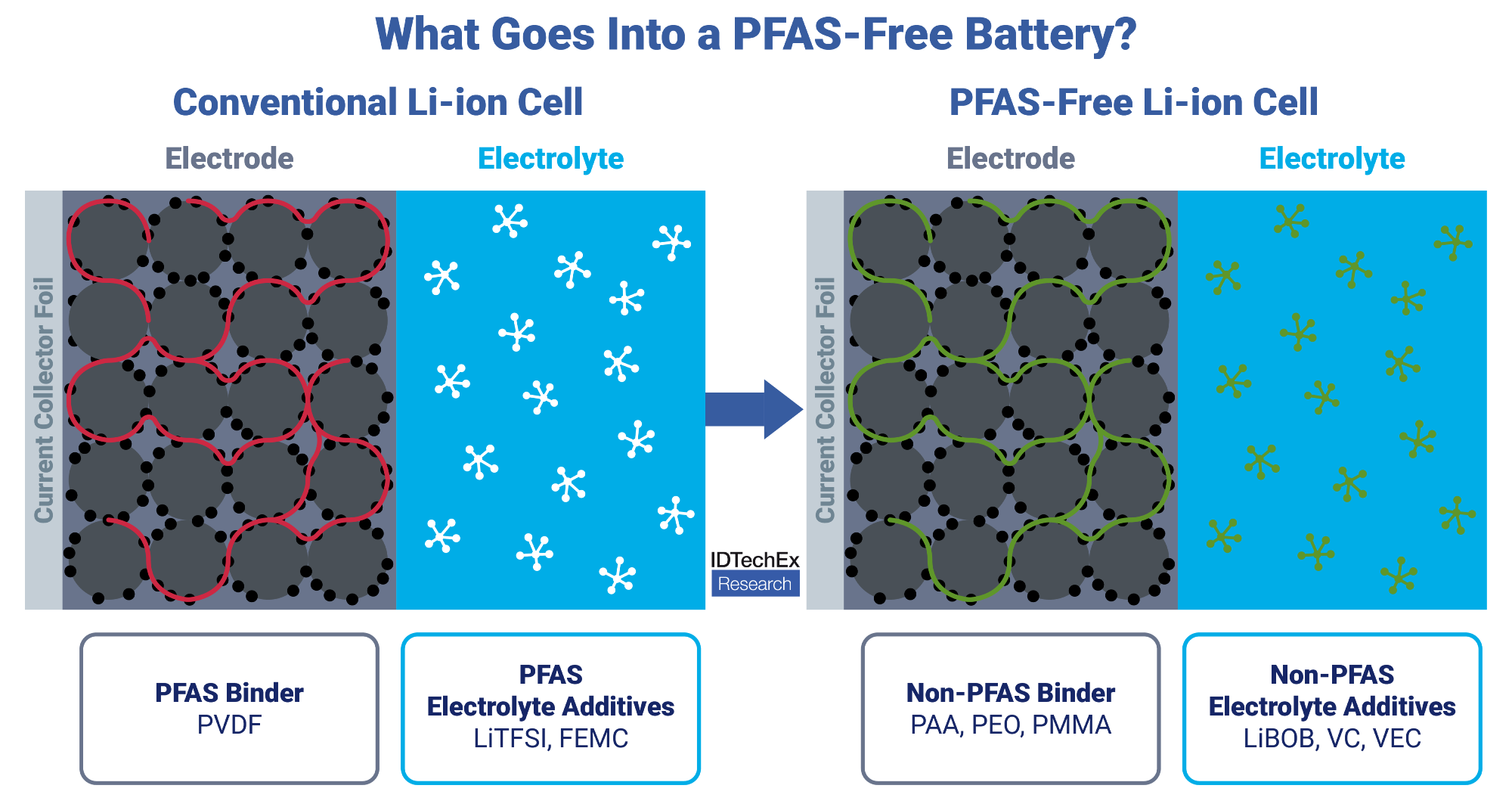"Forever chemicals", the colloquial term for the family of chemicals known as PFAS (per- and polyfluoroalkyl substances), is coming under increasing regulatory pressure globally, with mounting concerns over their negative health and environmental impacts. The battery industry, while it has been safe from early regulation, is now coming under greater scrutiny too for its continued use of PFAS.
 PFAS-free cells will require changes to the materials used as binders and electrolyte additives, Image Credit: IDTechEx
PFAS-free cells will require changes to the materials used as binders and electrolyte additives, Image Credit: IDTechEx
In the new “Additives for Li-ion Batteries and PFAS-Free Batteries 2026-2036: Technologies, Players, Forecasts” report, IDTechEx explores the uses of PFAS in today’s batteries, and identifies non-PFAS alternatives that will disrupt the battery material market to play a role in commercializing the first PFAS-free batteries. IDTechEx forecasts that the market for non-PFAS battery additives will exceed US$2 billion by 2036.
How and Why is PFAS Used in Batteries?
PFAS are a class of highly fluorinated synthetic materials, covering nearly 5,000 unique chemicals with a wide spectrum of applications. PFAS materials can pose significant harm to the environment and to public health – with increased cancer risks, drinking water contamination, and developmental delays among the most prevalent. Despite this, the unique properties of PFAS mean they still see widespread use across industries –and IDTechEx’s new report finds that the same is true in the battery industry.
PFAS materials offer excellent stability, conductivity, and adhesion, making them ideal for use as binders in Li-ion electrodes. While anode binder systems have moved away from PFAS, they remain widely used in cathodes, where PVDF (a PFAS material) is the dominant binder. As electrode manufacturing continues to evolve and dry electrode manufacturing processes emerge, PVDF is being replaced primarily by PTFE (yet another PFAS material).
PFAS are also highly suited for use as electrolyte additives, able to enhance conductivity and stability or to act as flame retardants. A wide range of PFAS materials can be used here, including PFAS-containing lithium salts, organic carbonates, and hydrofluoroethers, each with their own highly-tailored function within the electrolyte formulation.
However, with greater awareness of the harmful impacts of PFAS comes a growing threat of regulation. This is taking place at a time when Li-ion batteries are becoming increasingly important for their role in electric mobility and energy storage.
In response, IDTechEx’s “Additives for Li-ion Batteries and PFAS-Free Batteries 2026-2036: Technologies, Players, Forecasts” report has identified alternative non-PFAS materials and systems that can be used in their place in future PFAS-free Li-ion cells. The report also highlights key players developing this technology and the future direction of non-PFAS material research.
What are the Alternatives to PFAS?
For a non-PFAS material to play the same role within a cell, it has to possess most or all of the same properties as the relevant PFAS incumbent. Ideally, these materials would also be cheap, sustainable, and compatible with today’s cell production processes. Understandably, there are not many materials that can meet all these requirements and are commercially ready today. However, incremental steps are being taken to develop materials that will enable PFAS-free batteries.
On the binder front, Leclanche has already announced the removal of PFAS from its binder systems, and there is a wide array of polymers being explored as replacements to PVDF. These range from synthetic to bio-based, and from novel bespoke polymers to those that are used extensively in other commercial applications.
IDTechEx’s new “Additives for Li-ion Batteries and PFAS-Free Batteries 2026-2036: Technologies, Players, Forecasts” has found that polymers including polyacrylic acid (PAA) and polyethylene oxide (PEO) are among the leading non-PFAS alternatives, though each alternative is at differing stages of commercialization as discussed within the report. Elsewhere, players such as Nanoramic and 24M are developing binder systems that do not rely on polymers at all, highlighting the variety of solutions that are possible in remediating PFAS from binders.
Similar developments are taking place for electrolyte additives, with E-Lyte having recently announced a PFAS-free electrolyte formulation. The wide world of electrolyte additives does include a variety of non-PFAS materials which are commercially viable and can be used in PFAS-free cells. Additives like lithium bisoxalatoborate (LiBOB) and vinylene carbonate (VC) are already used in many cells and will only gain increased prominence in a post-PFAS market.
However, PFAS remediation is not as simple as direct substitution, due to the specificity of electrolyte formulations in each cell design. Instead, major material suppliers are hard at work developing specialized additives for PFAS-free electrolytes, insights into which can be found in the brand new IDTechEx report.
Outlook
The battery industry is developing methods for PFAS remediation as the threat of future regulation draws closer. While remediation is rarely as simple as direct substitution, novel materials are being developed that can take on similar roles within the cell as an equivalent PFAS material, with a handful of players already embracing the technology.
“Additives for Li-ion Batteries and PFAS-Free Batteries 2026-2036: Technologies, Players, Forecasts” highlights the anticipated evolution of the battery industry in response to growing concerns around PFAS. It lays out the uses of PFAS in cells today and identifies non-PFAS alternatives that will help the battery industry to comply with future PFAS regulations.
This includes benchmarking of key players developing PFAS-free battery materials and technology, analysis of patents, and of state-of-the-art research. Granular 10-year forecasts for both PFAS and non-PFAS battery additives provide more detailed insights into how quickly the material market is set to change out to 2036.